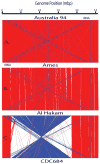The genome and variation of Bacillus anthracis
- PMID: 19729033
- PMCID: PMC3034159
- DOI: 10.1016/j.mam.2009.08.005
The genome and variation of Bacillus anthracis
Abstract
The Bacillus anthracis genome reflects its close genetic ties to Bacillus cereus and Bacillus thuringiensis but has been shaped by its own unique biology and evolutionary forces. The genome is comprised of a chromosome and two large virulence plasmids, pXO1 and pXO2. The chromosome is mostly co-linear among B. anthracis strains and even with the closest near neighbor strains. An exception to this pattern has been observed in a large inversion in an attenuated strain suggesting that chromosome co-linearity is important to the natural biology of this pathogen. In general, there are few polymorphic nucleotides among B. anthracis strains reflecting the short evolutionary time since its derivation from a B. cereus-like ancestor. The exceptions to this lack of diversity are the variable number tandem repeat (VNTR) loci that exist in genic and non genic regions of the chromosome and both plasmids. Their variation is associated with high mutability that is driven by rapid insertion and deletion of the repeats within an array. A notable example is found in the vrrC locus which is homologous to known DNA translocase genes from other bacteria.
Figures




References
-
- Bath J, Wu LJ, Errington J, Wang JC. Role of Bacillus subtilis SpoIIIE in DNA transport across the mother cell-prespore division septum. Science. 2000;290:995–997. - PubMed
Publication types
MeSH terms
Substances
Grants and funding
LinkOut - more resources
Full Text Sources

